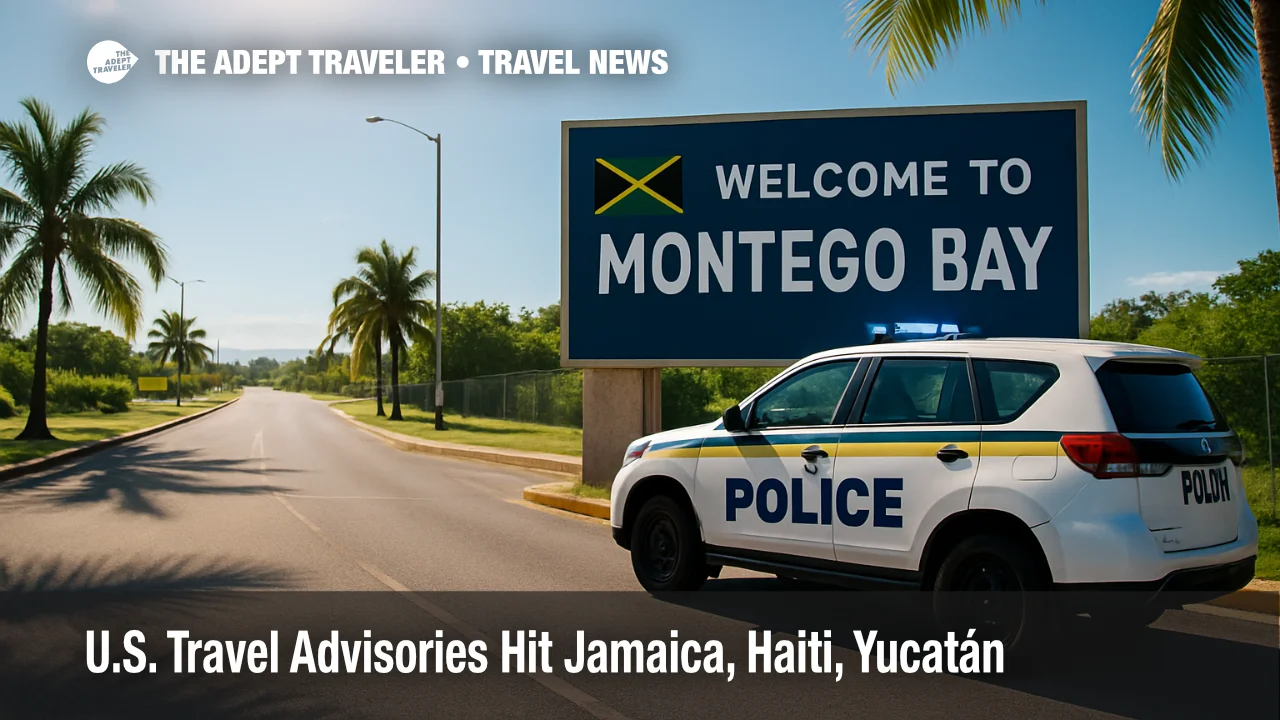U.S. Travel Advisories Hit Jamaica, Haiti, Yucatán

The State Department has tightened its travel guidance across key Caribbean and Mexican vacation corridors. Jamaica falls to Level 2 but retains multiple Level 4 no-go zones, Haiti remains Level 4, and Mexico's Quintana Roo stays Level 2 amid rising resort area shootings. Dominican Republic beach enclaves hold steady at Level 2. Here is how the color coded advisory scale works, and how specific travel-insurance endorsements can blunt "cancel for any reason" penalties.
Key Points
- Why it matters: New warnings affect four of the five most visited U.S. outbound beach markets, just ahead of Labor Day getaways.
- Travel impact: Resorts and airlines must honor DOT refund rules if flights are canceled; insurance with CFAR or IFAR can recoup 50-75 percent of non-refundable costs.
- What's next: Jamaica will update crime data this fall; insurers already report a surge in premium upgrades as travelers hedge against sudden advisories.
Snapshot
Jamaica is now Level 2 "exercise increased caution" overall, yet swaths of Kingston, Montego Bay, and rural parishes are marked Level 4 "do not travel." Haiti remains a full Level 4 due to kidnappings and airport insecurity. Mexico lists Yucatán state at Level 1, but neighboring Quintana Roo, including Cancún, Playa del Carmen, and Tulum, stays Level 2 after gang cross-fire injured tourists. The Dominican Republic, despite petty crime, retains Level 2 status at Punta Cana and Puerto Plata resorts.
Background
The State Department grades destinations on a four-tier scale updated at least annually, Levels 1 "normal precautions" through 4 "do not travel". Reviews accelerate when U.S. staffing or local security conditions shift. Tourism ministries track these shifts closely: when Jamaica dropped from Level 3 to Level 2 in May, arrival bookings jumped 11 percent within two weeks, according to Jamaica Tourist Board data. Conversely, Haiti's Level 4 designation has frozen commercial service at Toussaint Louverture International Airport since early 2024.
Latest Developments
Jamaica & Haiti crime trends
Jamaica's homicide rate, among the hemisphere's highest, still drives the advisory despite a 7 percent year-to-date decline. The advisory specifically bars travel to Spanish Town, sections of Montego Bay inland of the A1 highway, and more than a dozen parish districts. Haiti's July 15 bulletin cites rampant kidnappings and a standing FAA ban on U.S. commercial flights to Port-au-Prince, leaving humanitarian charters as the sole lifeline. U.S. citizens are urged to maintain evacuation plans that do not rely on embassy assistance.
Mexico & Dominican Republic security posture
While Yucatán state remains Level 1, Quintana Roo's advisory notes a rise in tourist-area shootings, urging travelers to stay in lit zones after dark and avoid unvetted taxis. The Mexican government's "Operation Summer Vacation 2025" added 7,000 troops to Cancún-Tulum corridors last week, aiming to reassure two million expected visitors. In the Dominican Republic, U.S. officials focus on phone snatch and grab incidents rather than violent crime, keeping guidance at Level 2.
Analysis
Advisory volatility is reshaping trip-planning economics. Allianz and InsureMyTrip report a record June uptake of premium coverages, especially Cancel For Any Reason (CFAR) riders that refund 50-75 percent of sunk costs if travelers bail for worries not named in a policy. Interruption For Any Reason (IFAR) add-ons mirror CFAR once a journey has begun, while "financial default" clauses protect prepaid tours if a hotel or airline shutters-coverage Squaremouth notes is standard in many interruption plans. Crucially, these endorsements override supplier imposed cancellation penalties but still require travelers to insure 100 percent of prepaid costs and act within 14-21 days of the first deposit. Without them, a Level 4 advisory alone seldom triggers automatic reimbursement unless the carrier cancels service. For risk-averse U.S. vacation planners, paying the 40-50 percent CFAR premium bump may be cheaper than forfeiting a $5 000 family package.
Final Thoughts
U.S. travel advisories can swing swiftly, especially in the Caribbean hurricane belt. Pairing real time State Department alerts with targeted CFAR or IFAR endorsements keeps you in control, whether you press ahead or pull the plug. In uncertain times, understanding, and insuring against-the advisory ladder is the most practical way to navigate ever shifting U.S. travel advisories.
Sources
- Jamaica Travel Advisory - U.S. State Department
- Haiti Travel Advisory - U.S. State Department
- Mexico Travel Advisory (Quintana Roo) - U.S. State Department
- About U.S. Travel Advisory Levels - U.S. State Department
- Quintana Roo launches 2025 summer security operation - Government of Quintana Roo
- Premium insurance demand rises with global travel disruptions - Reuters
- Stock market uncertainty makes many Americans wary of spending on travel - Reuters
- Trip Cancellation Insurance: Coverage, Cost & Plans - Squaremouth
